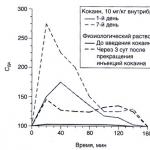How does the fogging system work?
The fogger works according to the principle of natural natural conditioner, waterfall: the water suspension constantly evaporates, while taking away heat from the air.
When turned on pump unit At 70 bar, a stream of water under high pressure moves to the nozzles of the system, where water droplets turn into particles 5 microns in size, resulting in a lightning-fast evaporation effect. Fog lowers the temperature of the surrounding space, and the more liquid is involved, the lower the air temperature will be.
This process is “thermodynamic”. It is effective due to the fact that it takes a lot of energy to evaporate water (evaporation of 1 gram of water requires 600 calories of heat). The release of this energy leads to a decrease in temperature. The overall efficiency of the system depends, of course, on the temperature and humidity of the air. When the temperature increases (ideal temperatures for system operation are temperatures in the range from 29 to 45oC) and air humidity decreases (at humidity above 90% the system performance is low, at humidity in the range from 40% to 90% the systems work well, at humidity below 40% they work best) the results of the system can be very significant. Obviously, the more liquid involved in the process, the stronger the cooling effect.
Advantages of fogging systems:
- Can lower temperature up to 15 degrees Celsius;
- Economical in water consumption (consumption for a classic gazebo is up to 2 liters/hour);
- Low energy consumption;
- Safe to use (ordinary water is used);
- The control unit and pump are protected by special anti-vandal housings
- Warranty and post-warranty service.
Where will fogging be needed?
Artificial fog system is perfect solution when it is necessary to lower the temperature, create a pleasant microclimate and required level humidity, so in hot weather summer time, when the temperature goes off scale, foggers become especially relevant for cafes with open terraces and for summer areas.
Fogging systems are installed in cafes, restaurants, hotels, amusement parks, tennis courts and clubs. The fogging plant also found decorative use in swimming pools to supplement landscape design and creating various visual effects.
Where can I buy foggers?
Our company supplies equipment for fogging throughout Ukraine and the CIS. Our experienced specialists will prepare a project and calculate the cost of the fogging system; prices can be found in the catalog of gazebos.
If you are interested in the idea of using artificial fog on the terrace of your cafe or you simply decide to buy fogging systems for your veranda country house, please contact our managers.
- I'll be wet, it won't work for me or it will work for me. Initially, fogging systems were designed to cool open areas, i.e. for working outdoors. Since the principle of the cooling system is a phase transition between the liquid and gaseous state of water, two main factors must be taken into account for successful cooling. Air temperature and relative humidity(air saturation with water vapor). Most important factor- this is the possibility of air exchange if the room is completely closed without forced ventilation, the fog cooling system will saturate the air with moisture after some time, the water will stop evaporating and the cooling effect will completely disappear. If the room is sufficiently open or has a forced ventilation system, then the fogging system can be adapted for maximum cooling efficiency. To summarize, if someone gets wet from a fog system, it is an indication that the system is not properly designed or operated properly. As an example, the fogging system, without any noticeable humidification, worked in closed exhibition centers, and at an ambient temperature of about 23 ° C, it significantly reduced the temperature.
- The fogging system is an outdoor air conditioner. Indeed, the fog cooling system is designed to cool the air in open spaces, but it has a number of differences with the usual air conditioning system. Firstly, the fog cooling system is an open type system, i.e. The refrigerant (in our case, water) does not evaporate in the closed volumes of air conditioner evaporators, but directly in the places where people stay, so such a system requires a continuous supply of water. Secondly, fogging systems cannot be programmed to a certain temperature, for example, 23 degrees, as we are used to with conventional air conditioners, such cooling systems are controlled using timers and regulate the operating time and pauses of the fog cooling system, you just need to get used to such control. But instead of a conventional air conditioner, we get a very environmentally friendly system for creating a favorable microclimate in a given area. The fog cooling system will not only reduce the temperature, but also reduce dust, raise the humidity level to a comfortable level, eliminate or significantly reduce the number of flying insects, eliminate unpleasant odors. It will create a so-called comfort zone, and in any case, nothing better has appeared on the market for cooling open areas.
- Fogging systems low pressure it's cheaper and just as effective. As logic dictates, if there are simple, cheap, low-pressure fogging systems, then why produce noisy, expensive systems? high pressure. The answer is simple low pressure fogging systems ( working pressure from 1 to 25 bar) are mostly created on the basis of atomizing disks or nozzles with a large outlet, and such technologies do not allow obtaining a droplet smaller than 25-40 microns. This droplet size effectively evaporates at ambient temperatures starting from approximately 40-43 ° C, at more low temperatures Such systems work more to moisturize surfaces. High-pressure fogging systems (working pressure from 65 to 80 bar) create a droplet with a size of 5 to 15 microns. And as I already wrote, they can be used at ambient temperatures of 23 ° C and above, it all depends on the configuration and settings of the system. Draw your own conclusions.
- High pressure fogging systems increase their efficiency when the pressure is greater than 100 bar. This is not entirely true, or rather not at all; in fact, the lower pressure limit is important, i.e. if the pressure gauge on your fogging system exceeds 60 bar. Then you can be sure that your system is working normally, and the droplet size does not exceed 7-15 microns, which is very good. Optimal pressure for fogging systems it is 80 bar (droplet size 7-10 microns). As the pressure increases, the droplet size does not change significantly, but the amount of water passing through the nozzle per unit time increases. Thus, if you are offered a 100 bar pump. The price is higher than the 80 bar pump. It's just a waste of money.
- Curtain or not curtain, how to correctly design the arrangement of nozzles for a fogging system? In fact, there are no specific dogmas or rules according to which you can arrange the nozzles of a fog cooling system or use fog-forming fans. In each specific case, the designer proceeds from the realities of your object. A lot of factors are taken into account, for example: roof material, if present, room configuration, number of open and closed walls, ceiling height, general ventilation of the room, interior elements ( lighting fixtures, decorative ceiling coverings, suspended or high-standing flowerpots with flowers, etc.), external decorative elements, installation possibility, fogging systems, removal of the cooling object from the place possible installation high pressure pump and many different little things and nuances. Only by fully analyzing all possible factors can you achieve maximum efficiency of a fog cooling system.
- Why do you need a timer? The timer is the only device for changing the operating mode of the fogging system. The timer, by changing the operating time and pause, allows you to significantly expand the temperature and humidity range of the fog cooling system. For example: in the morning the air temperature is not yet too high, but it is already getting hot, the fog formation is too dense and excessive humidification is obtained, the fog cooling system without a timer will have to be turned off, but if your “outdoor air conditioner” is equipped with a timer, you can set the operating time and pauses and continue to enjoy the established pleasant microclimate. The same can be said about hot but cloudy days with high humidity.
- A nozzle broken by high pressure can fly off and cause injury. This is not true, since street air conditioning systems have very little water intake; even with the smallest water leak, which appears when the nozzle is cracked or broken, the pressure in the system drops at lightning speed, as a result of which the nozzle cannot fly anywhere, much less injure someone.
- Fogging nozzles are afraid of “salty water”. It all depends on the degree of saltiness when served sea water, then most likely the pump will fail quite quickly. If we talk about well or tap water, then for 6 years there has been no case of irreversible failure of elements of the fog cooling system. If the fogging system is energized well water without softening, and the water is quite strongly saline, then when preserving the system, it is necessary to rinse it with purified water. Although there was a case when, despite our recommendations, the injectors were left until the end of the operating season without flushing. next summer. It should be noted that the “street air conditioning” system was powered by a well with a high level of salts. When the system started, out of 35 nozzles, 3 were working. But as a result of simple manipulations with vinegar and toothpicks, after an hour the system was working at the proper level. WITH tap water no such cases were observed.
- The fogging system can be heated if applied to the system input hot water. This is not the case even if hot air is sprayed at low temperatures. fine dust then since hot water needs much less energy for a phase transition and the air is quite dry, the water will still evaporate, which will lead to cooling, or at a very low temperature to crystallization, that is, snow will fall. But one thing is for sure, the high-pressure pump will fail very quickly, since the plunger block is cooled by water passing through it and if hot water is supplied, the pump will overheat and break.
- Mobile or stationary fogging system. The biggest disadvantage of a mobile fog cooling system is its price. A mobile module costs on average 60-80% more than its stationary counterpart. Meet budget options mobile “cooling-humidifying” systems, these are usually low-pressure disk systems, as described above. There are also mobile cooling modules manufactured in the east; such systems are much cheaper than their European and American counterparts, but if you compare the cost of eastern stationary fogging systems with mobile systems of the same name, the price proportion will remain the same. Usually, mobile systems manufactured in Europe or America use expensive quiet high pressure pumps, i.e. Eastern manufacturers do not care about reducing background noise, which actually explains the significant difference in price between brands. However, the noise factor of the mobile system has great value. If the high-pressure pump of a stationary system can be hidden in a technical room remote from the area of direct use, then the mobile cooling module will make noise near you.
An important property of high-pressure fog is the ability of small droplets of fog to quickly evaporate by absorbing heat from the air.
Due to their small size, water droplets evaporate quickly. It is evaporation, that is, the transition from liquid to gaseous state, that absorbs heat from the air. Specific heat evaporation of water at a temperature of 15 °C is equal to 2466 kJ/kg or 589 kcal/kg. The lower the relative humidity, the more water can be evaporated and, accordingly, more heat is absorbed from the air. The specific energy consumption for evaporation of 1 kg of water ranges from 2.5 to 10 W per hour, depending on the size of the fogging system.
Only a pressure of 70–80 bar will provide a uniform and fine mist with a droplet size of about 10 microns, which evaporates immediately and does not fall out in the form of wet spots and puddles on surfaces and equipment. Such fog improves working conditions for personnel or increases comfort for visitors, maintains technological air parameters in production and warehouses, maintains the quality of raw materials and finished products, protects equipment and environment from dust or odors.
With the help of a mist cooling system, you can provide pleasant coolness on the terrace or in the gazebo, and at the same time ward off annoying insects. On hot days summer days these questions become especially relevant
Mist cooling is the only technology available today that can lower temperatures by outdoors. Such systems are actively used in industry, they can be found in hotels, summer cafes and restaurants. And for a simple summer resident, the fog will give freshness and comfort where it is impossible to install a regular air conditioner - in a gazebo, on a barbecue area, etc.
Cold mist can be useful in the garden, both outdoors and in greenhouses and conservatories. It is used to protect plants that do not tolerate heat well.
Fog cooling circuit
Fog cooling lowers the air temperature by 5-15°C. How? The “heart” of the system is a pump that forces water under pressure of 70 bar (7000 kPa) through nozzles with tiny holes, creating a cloud of droplets no larger than 10 microns in size. They immediately begin to evaporate, and it is this process (transition from liquid state into gas) takes away from air thermal energy. Moreover, the drier the air, the more moisture it picks up, and the more it cools. It's no surprise that mist cooling systems are particularly popular in arid regions.
The system is modular, mobile and compact; it can be installed almost anywhere, and you can do it yourself. With the help of special fasteners, usually included in the kit, many nozzles can be easily positioned over any area, creating a uniform, efficient curtain of tiny droplets of water. Moreover, the market offers pumpless mist cooling kits that can be connected to normal system garden irrigation.
Another advantage of this technology is that it is inexpensive to operate. Thus, it takes only 2.5-10 W per hour to evaporate 1 kg of water (depending on the characteristics of the specific air cooling system).
With the help of fog cooling, you can not only lower the air temperature, but also purify it, and also drive away insects
In addition to the heat, summer residents are often bothered by dust, and cold fog effectively combats this problem. Tiny droplets of water bind dust particles, weighing them down and causing them to sink down instead of swirling around.
But that's not all. If you add deodorizing agents to the water, you can use an evaporative cooling system to purify the air, getting rid of unpleasant odors.
And if you add repellents to the water, mosquitoes, wasps, bees and other annoying insects will stop bothering vacationers. It is important that the health of people and pets will not be harmed in the slightest.
Having completed the review of practical functions, we will also mention aesthetic ones. With the help of cold fog, you can achieve various visual effects that will turn the usual garden plot to a fairyland. Nozzles located at different angles create curtains, balls, clouds and other shapes. All components of the system - pipes, fittings, etc. - can be hidden in the ground, under terraced flooring, mounted under eaves overhangs or attach to tensioned cables.
A fogger is a system that sprays water under high pressure. It provides an increase in humidity and a decrease in air temperature, which is important for any greenhouse in summer heat. You can purchase a fogger or try to make it yourself. Step-by-step instructions for assembling the atomizer are in this article and in a unique video.
Importance of fogger for plants
A natural example of a natural air conditioner is a waterfall. The same principle is inherent in fogging systems. High-pressure water is turned into jets of mist that remove heat from the air.

In industrial greenhouses and winter gardens With exotic plants Foggers have been used for a long time. The systems are also popular in the field of landscape design and site development. The clouds of fog look gorgeous all around artificial reservoirs or alpine slides. And equipping the veranda with such a system will allow you to calmly enjoy your holiday in any heat.

Many summer residents believe that foggers are an unnecessary luxury for small farm greenhouses, because cucumbers and tomatoes can be grown without them. However, there are a number of advantages to using it that are quite difficult to refuse.
- Thanks to the installation, a microclimate appears in the greenhouse, suitable for exotic and moisture-loving plants. For example, cucumbers love high humidity.
- Seedlings develop much faster, because they absorb moisture not only with their roots, but also with their leaves.
- It has been noticed that flowers when grown with a fogger acquire brighter colors.
- Through the installation, you can effectively and economically spray plants with water-soluble fertilizers and agents that protect against diseases and pests.
- If you turn on the system on a hot summer day, the temperature in the greenhouse will drop by about 15 °C. Therefore, the device is also called a water conditioner.
The disadvantage of the system is that it can be used mainly in the summer. In winter - only in well-heated rooms.

How does a fogger work?
An industrial fogger works using special devices, sprinklers. Thanks to them, water is sprayed into droplets measuring 5-10 micrometers. This is thinner than a human hair, whose thickness is 80 microns. These tiny droplets instantly evaporate, cooling the air and increasing humidity.
Attention! The water spray device is most effective at a temperature of 30-40 °C.

Standard fog systems are made from:
- pump;
- nozzles;
- control panels. It in turn consists of a hygrometer, a controller and a control unit.
All kinds of foggers and their components can be found in online stores. The choice is huge; for example, it is known that there are about 20 thousand varieties of nozzles.

The average price of a fogger (part of a system) with four nozzles is 110 rubles. And herself automatic system spraying can cost from 30 to 100 thousand rubles. depending on power and configuration.
The innovation has not yet become widespread among summer residents. Judging by the reviews, only a few people use it. The more valuable step by step instructions on how to make a fogger with your own hands.
How to assemble a fogger for a greenhouse
Advice. The pipe with fittings must be mounted at a height of at least 2 m.
Assembled own system There are no particular difficulties for fogging. It works on the same principle as devices industrial production, simply constructed from more affordable components.

You will need:
- thin tube with a diameter of 5-7 mm. Its length should be equal to the area of the greenhouse;
- special lock that controls pressure;
- about 30 fittings (depending on the size of the greenhouse);
- there are as many nozzles as there are fittings;
- filter;
- pump.

Action steps:
- First you need to assemble the line with the injectors.
- The nozzles must be installed along the length of the tube at a distance of 80 cm from each other.
- Attach a lock to the pipe that compresses it more strongly if the pressure in the system increases.
- Attach a nozzle to each fitting.
- Secure the main pipe with fittings around the perimeter of the greenhouse at ceiling height. In corners you can simply bend the tube or use corner fittings.
- Place a cap at the end of the outermost branch.
- A fine filter is installed in the water supply.
- Then the high pressure pump is connected. And there is a ready-made wiring for it. The system is ready.

You can purchase a ready-made fogger for the greenhouse
A purchased or home-made fogger consumes a minimum of water and electricity. At the same time, it is able to provide greenhouse plants with the humidity they need and lower the air temperature to the optimum.
Fogging system in a greenhouse - video

















